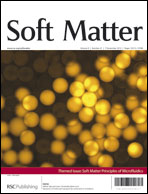This paper describes the use of a microfluidic device to produce porous, hierarchical nano-patterned microspheres. Within this device, explicit control over the micro-phase separation and macro-phase solidification behaviour of a polystyrene–polyethylene oxide di-block copolymer dissolved in an organic (polar) solvent droplet has been achieved through the tailoring of the staged onset of diffusion induced phase separation (DIPS) and thermally induced phase separation (TIPS) events post dispersion in an aqueous continuous phase. Due to water and the organic solvent (dimethylene carbonate (DMC)) being partially miscible, the organic solvent within the dispersed phase diffuses very slowly out of the polymer-loaded droplets into the continuous transport fluid (water) as they flow down the microchannel. This permits controlled shrinkage of the droplets (and hence sizing), and the eventual condensation of the external surface of the polymer microbeads, prior to the timed onset of TIPS, which promotes the formation of a highly porous internal structure (via liquid–liquid macrophase separation) within the microbeads. The thickness of the external layer can be controlled by varying the timeframe for DIPS, along with porosity of the internals of these hierarchical microbeads by varying the TIPS parameters. The resulting monodisperse hierarchical microspheres are comprised of external surfaces decorated with nano-scale self-assembled block copolymer domains, while the internal structure is highly porous and all surfaces display the same nano-scale domains. The hydrophilic nature of the PEO nano-domains results in these microparticles being near neutrally buoyant in water and bioactive moieties can be presented on the terminal ends of the PEO chains in each domain. These novel microparticles are thus seen as ideal for bead-based cell culture applications and the use of this methodology with degradable block copolymers ideal for future application in regenerative medicine.

You have access to this article
 Please wait while we load your content...
Something went wrong. Try again?
Please wait while we load your content...
Something went wrong. Try again?


 Please wait while we load your content...
Please wait while we load your content...